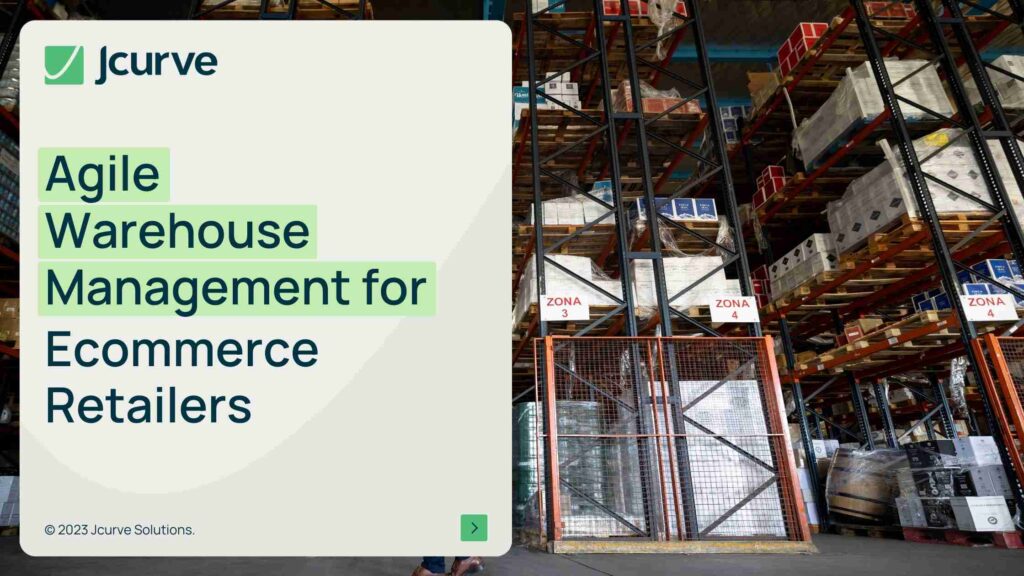Agile Warehouse Management stands out as a cornerstone for ecommerce retailers. As digital shopping continues to grow, adopting agile strategies ensures businesses remain competitive and responsive to ever-changing market demands. To navigate these dynamics, many retailers are adopting agile warehouse management systems. This article will explore what agile warehouse management is, why it is crucial for ecommerce, the benefits it offers, and how to implement it successfully.
What is agile warehouse management?
Agile warehouse management refers to the use of flexible, adaptable, and responsive practices within warehouse operations to meet changing market demands. This approach focuses on enhancing speed, efficiency, and the ability to scale operations quickly. Agile warehouse management contrasts with traditional models by emphasizing real-time data, adaptive processes, and continuous improvement.
What is the agile logistics system?
An agile logistics system extends the principles of agility to the entire logistics process, from inventory management to delivery. It focuses on minimizing lead times, optimizing resource use, and swiftly adjusting to disruptions.
This system often involves technology such as automated guided vehicles (AGVs), smart shelves, and real-time tracking systems, which help streamline logistics operations and ensure products move swiftly through the supply chain.
What is an agile supply chain management system?
Agile supply chain management refers to the broader application of agility principles across the entire supply chain, from procurement to customer delivery. An agile supply chain is designed to respond rapidly to changes in customer demand, supply disruptions, or market shifts. Key features include close collaboration with suppliers, leveraging data analytics for demand forecasting, and maintaining flexible production and distribution processes.
Why do you need Agile Management in Ecommerce?
Agile management allows retailers to respond quickly to these changes by adapting inventory levels, optimizing order fulfillment, and maintaining high service levels. Traditional warehouse models, which rely on fixed processes and rigid schedules, often fall short in meeting these dynamic needs.
Agile inventory management, a core component of agile warehousing, helps retailers optimize stock levels, reduce excess inventory, and ensure that products are available when customers need them. The integration of agile principles also supports digital transformation in warehousing, which can significantly enhance operational efficiency by automating routine tasks and improving data accuracy.
Traditional warehousing approaches often don’t measure up to these dynamic demands, underscoring the critical role of Agile Inventory Management. To understand how to adapt to these changes, read ‘Demand Forecasting with NetSuite WMS: Predict, Plan, and Prosper‘. Furthermore, the push towards Digital Transformation in Warehousing has accentuated the urgency for agile practices. As highlighted in a recent study, digital transformations can amplify operational efficiency.
Integration of WMS with Ecommerce Platforms
Integrating Warehouse Management Systems (WMS) with ecommerce platforms is crucial for achieving agility. This integration allows for real-time synchronization of inventory data, order management, and shipping processes, leading to faster and more accurate order fulfillment. A well-integrated WMS can dynamically allocate inventory, automate replenishment, and provide visibility across the supply chain, enabling retailers to respond promptly to customer demands.
Benefits of Agile Warehousing in Retail
- Improved Responsiveness: Agile warehousing enables quick adaptation to changes in demand, minimizing delays and enhancing customer satisfaction.
- Enhanced Efficiency: Automation and real-time data reduce manual errors, streamline processes, and increase operational efficiency.
- Cost Savings: By optimizing inventory levels and reducing waste, agile warehousing helps lower operational costs.
- Scalability: Agile systems can easily scale up or down based on market conditions, allowing retailers to handle peak periods without overcommitting resources.
- Better Risk Management: Agile warehousing provides greater flexibility to address supply chain disruptions, such as delayed shipments or sudden demand spikes.
6 Principles of Agile Warehousing
1. Flexibility
Agile warehousing emphasizes the ability to quickly adapt to changes, such as fluctuating demand, new product lines, or unexpected disruptions. Flexible processes enable warehouses to switch between tasks without significant downtime, ensuring smooth operations even during peak periods.
2. Collaboration
Strong communication and collaboration across all supply chain partners, including suppliers, logistics providers, and internal teams, are crucial. Collaborative efforts ensure that everyone is aligned with shared goals, improving coordination and overall supply chain efficiency.
3. Continuous Improvement
Agile warehousing involves regularly reviewing and refining processes to eliminate inefficiencies, reduce waste, and optimize performance. Continuous improvement fosters a culture of innovation, where small, incremental changes drive significant long-term benefits.
4. Customer-Centricity
Putting the customer at the heart of warehouse operations ensures that processes are tailored to meet their expectations. This principle focuses on fast, accurate, and reliable order fulfillment, with a proactive approach to handling returns, customer feedback, and service improvements.
5. Technology Integration
Leveraging advanced technologies such as WMS, automation, IoT, and data analytics helps warehouses make data-driven decisions, enhance operational agility, and improve inventory management. Technology integration is a cornerstone of agile warehousing, enabling real-time visibility and efficiency.
6. Scalability
Agile warehousing systems are designed to scale up or down easily in response to market changes. Scalable solutions, such as modular automation and adaptable layouts, allow warehouses to expand capacity during peak seasons and scale back when demand slows, ensuring resources are used efficiently.
How to Achieve Agile Warehouse Management?
To achieve agile warehouse management, start by implementing a flexible Warehouse Management System (WMS) that integrates with your ecommerce platform for real-time data sharing and process automation. Embrace automation technologies like robotic picking and conveyor systems to speed up operations. Enhance visibility through data analytics and IoT devices to monitor inventory, track shipments, and predict demand.
Invest in training programs to empower your workforce to adapt quickly to new technologies and workflows. Finally, design your warehouse layout and processes with scalability in mind to effectively handle fluctuations in order volume. These strategies combined will create a more responsive and efficient warehouse operation.
Challenges and Solutions
One major challenge in implementing agile warehouse management is the high initial cost of technology integration. To address this, companies can start with scalable solutions and gradually implement new technologies based on careful ROI analysis. This approach allows for a more manageable investment spread over time while still moving towards a more agile operation.
Another significant hurdle is resistance to change among employees. To overcome this, organizations should focus on providing comprehensive training programs and clearly communicating the benefits of agile practices. By gaining employee buy-in through education and transparency, warehouses can more smoothly transition to new systems and processes.
Maintaining data accuracy in a rapidly changing environment poses a third challenge. To ensure data integrity, warehouses should implement real-time data capture tools and conduct regular system audits. These measures help prevent errors and inconsistencies, allowing for more reliable decision-making and efficient operations in the agile warehouse ecosystem.
Future Trends in Agile Warehouse Management
1. Increased Use of AI and Machine Learning
AI-driven demand forecasting and warehouse automation will become more prevalent, enhancing decision-making capabilities.
2. Robotics and Autonomous Vehicles
The use of robots for picking and packing and autonomous vehicles for inventory movement will continue to grow.
3. Blockchain for Transparency
Blockchain technology will enhance supply chain transparency, ensuring traceability and reducing fraud.
4. Sustainability Initiatives
Agile warehousing will increasingly incorporate eco-friendly practices, such as energy-efficient technologies and sustainable packaging.
Conclusion
Agile warehouse management has become an essential strategy for ecommerce retailers striving to keep pace with a rapidly changing market landscape. The integration of Warehouse Management Systems (WMS) with ecommerce platforms plays a critical role in achieving these outcomes, enabling real-time data synchronization, automation, and seamless order management.
Agile warehousing offers numerous benefits, including cost savings, scalability, and better risk management, making it a valuable asset for retailers looking to optimize their supply chain. However, implementing agile practices requires a commitment to flexibility, collaboration, continuous improvement, technology integration, and scalability. Overcoming challenges such as high initial costs and resistance to change will further position retailers to thrive.
In the competitive world of ecommerce, agility is not just an advantage – it’s a necessity. By leveraging Agile Management in Ecommerce, retailers can gain a competitive advantage, stay ahead of market changes, meet customer demands, and ensure operational efficiency. To further empower your business in this ever-evolving landscape, explore how Jcurve Solutions can provide the tools and strategies you need.










